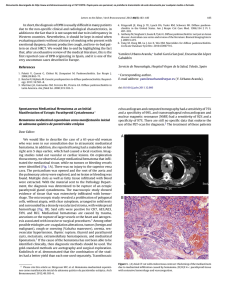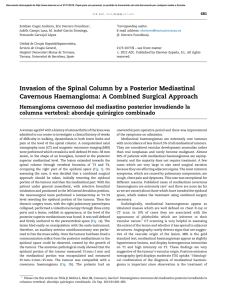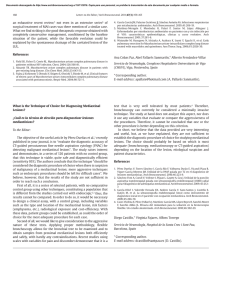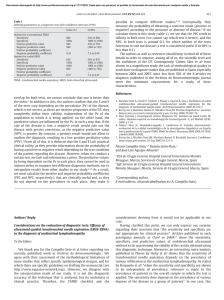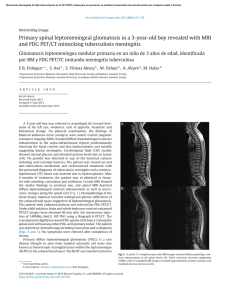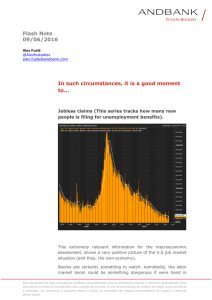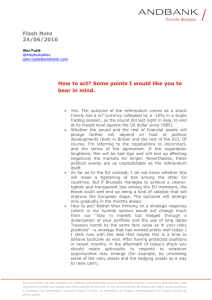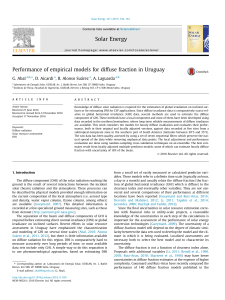Diffuse Panbronchiolitis: A Very Rare Disease in Western Countries
Anuncio
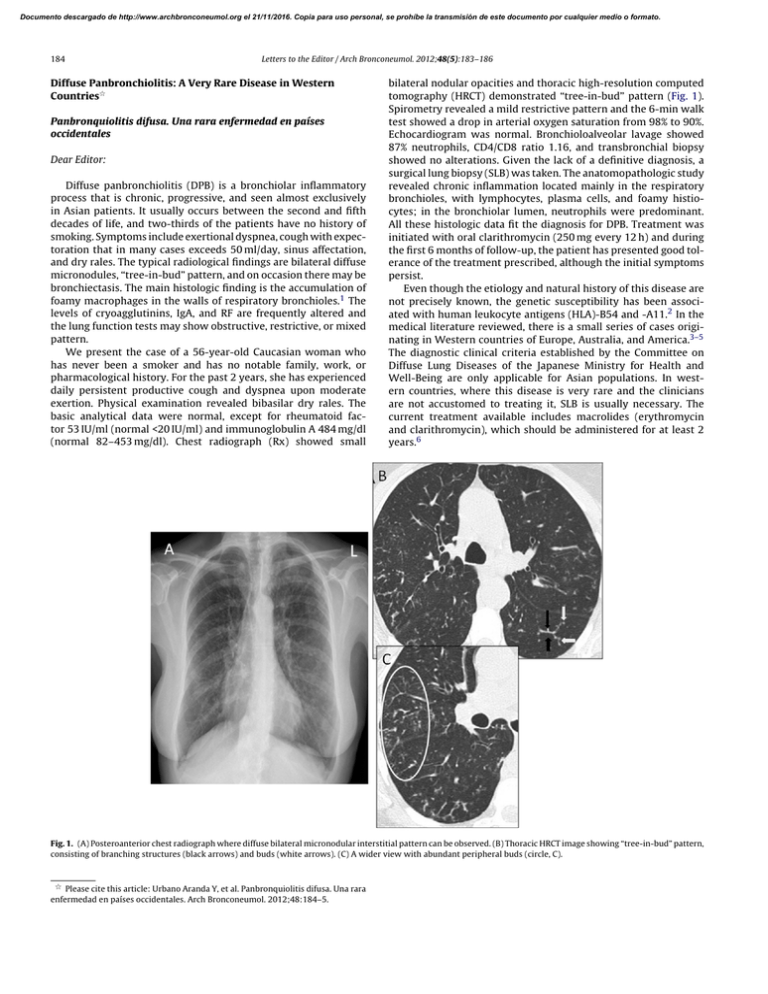
Documento descargado de http://www.archbronconeumol.org el 21/11/2016. Copia para uso personal, se prohíbe la transmisión de este documento por cualquier medio o formato. 184 Letters to the Editor / Arch Bronconeumol. 2012;48(5):183–186 Diffuse Panbronchiolitis: A Very Rare Disease in Western Countries夽 Panbronquiolitis difusa. Una rara enfermedad en países occidentales Dear Editor: Diffuse panbronchiolitis (DPB) is a bronchiolar inflammatory process that is chronic, progressive, and seen almost exclusively in Asian patients. It usually occurs between the second and fifth decades of life, and two-thirds of the patients have no history of smoking. Symptoms include exertional dyspnea, cough with expectoration that in many cases exceeds 50 ml/day, sinus affectation, and dry rales. The typical radiological findings are bilateral diffuse micronodules, “tree-in-bud” pattern, and on occasion there may be bronchiectasis. The main histologic finding is the accumulation of foamy macrophages in the walls of respiratory bronchioles.1 The levels of cryoagglutinins, IgA, and RF are frequently altered and the lung function tests may show obstructive, restrictive, or mixed pattern. We present the case of a 56-year-old Caucasian woman who has never been a smoker and has no notable family, work, or pharmacological history. For the past 2 years, she has experienced daily persistent productive cough and dyspnea upon moderate exertion. Physical examination revealed bibasilar dry rales. The basic analytical data were normal, except for rheumatoid factor 53 IU/ml (normal <20 IU/ml) and immunoglobulin A 484 mg/dl (normal 82–453 mg/dl). Chest radiograph (Rx) showed small bilateral nodular opacities and thoracic high-resolution computed tomography (HRCT) demonstrated “tree-in-bud” pattern (Fig. 1). Spirometry revealed a mild restrictive pattern and the 6-min walk test showed a drop in arterial oxygen saturation from 98% to 90%. Echocardiogram was normal. Bronchioloalveolar lavage showed 87% neutrophils, CD4/CD8 ratio 1.16, and transbronchial biopsy showed no alterations. Given the lack of a definitive diagnosis, a surgical lung biopsy (SLB) was taken. The anatomopathologic study revealed chronic inflammation located mainly in the respiratory bronchioles, with lymphocytes, plasma cells, and foamy histiocytes; in the bronchiolar lumen, neutrophils were predominant. All these histologic data fit the diagnosis for DPB. Treatment was initiated with oral clarithromycin (250 mg every 12 h) and during the first 6 months of follow-up, the patient has presented good tolerance of the treatment prescribed, although the initial symptoms persist. Even though the etiology and natural history of this disease are not precisely known, the genetic susceptibility has been associated with human leukocyte antigens (HLA)-B54 and -A11.2 In the medical literature reviewed, there is a small series of cases originating in Western countries of Europe, Australia, and America.3–5 The diagnostic clinical criteria established by the Committee on Diffuse Lung Diseases of the Japanese Ministry for Health and Well-Being are only applicable for Asian populations. In western countries, where this disease is very rare and the clinicians are not accustomed to treating it, SLB is usually necessary. The current treatment available includes macrolides (erythromycin and clarithromycin), which should be administered for at least 2 years.6 Fig. 1. (A) Posteroanterior chest radiograph where diffuse bilateral micronodular interstitial pattern can be observed. (B) Thoracic HRCT image showing “tree-in-bud” pattern, consisting of branching structures (black arrows) and buds (white arrows). (C) A wider view with abundant peripheral buds (circle, C). 夽 Please cite this article: Urbano Aranda Y, et al. Panbronquiolitis difusa. Una rara enfermedad en países occidentales. Arch Bronconeumol. 2012;48:184–5. Documento descargado de http://www.archbronconeumol.org el 21/11/2016. Copia para uso personal, se prohíbe la transmisión de este documento por cualquier medio o formato. Letters to the Editor / Arch Bronconeumol. 2012;48(5):183–186 In short, the diagnosis of DPB is usually difficult in many patients due to the non-specific clinical and radiological characteristics, in addition to the fact that it is not suspected due to its infrequency in Western countries. Nevertheless, it should be kept in mind when evaluating patients without a history of smoking who present with exertional dyspnea, chronic productive cough, and tree-in-bud pattern on chest HRCT. We would like to end by highlighting the fact that, after an exhaustive review of the medical literature, this is the first reported case of DPB originating in Spain, and it is one of the very uncommon cases described in Europe. References 1. Poletti V, Casoni G, Chilosi M, Zompatori M. Panbronchiolitis. Eur Respir J. 2006;28:862–71. 2. Keicho N, Hijikata M. Genetic predisposition to diffuse panbronchiolitis. Respirology. 2011;16:581–8. 3. Martinez JA, Guimarães SM, Ferreira RG, Pereira CA. Diffuse panbronchiolitis in Latin America. Am J Med Sci. 2000;319:183–5. Spontaneous Mediastinal Hematoma as an Initial Manifestation of Ectopic Parathyroid Cystadenoma夽 Hematoma mediastinal espontáneo como manifestación inicial de adenoma quístico de paratiroides ectópica 185 4. Fitzgerald JE, King Jr TE, Lynch DA, Tuder RM, Schwarz MI. Diffuse panbronchiolitis in the United States. Am J Respir Crit Care Med. 1996;154 2 Pt 1: 497–503. 5. Anthony M, Singham S, Soans B, Tyler G. Diffuse panbronchiolitis: not just an Asian disease: Australian case series and review of the literature. Biomed Imaging Interv J. 2009;5:e19. 6. Yang M, Dong BR, Lu J, Lin X, Wu HM. Macrolides for diffuse panbronchiolitis. Cochrane Database Syst Rev. 2010:CD007716. Yamilex Urbano Aranda,∗ Isabel García San José, Encarnación López Gabaldón Servicio de Neumología, Hospital Virgen de la Salud, Toledo, Spain ∗ Corresponding author. E-mail address: [email protected] (Y. Urbano Aranda). doi:10.1016/j.arbr.2011.12.006 echocardiogram and computed tomography had a sensitivity of 75% and a specificity of 99%, and transesophageal echocardiogram and nuclear magnetic resonance (NMR) had a sensitivity of 92% and a specificity of 97%. There are still no specific data that endorse the use of the PET-scan for diagnosis.2 The treatment of these patients Dear Editor: We would like to describe the case of a 61-year-old woman who was seen in our consultation due to atraumatic mediastinal hematoma. In addition, she reported having had a snakebite on her right arm 5 days earlier, which had caused a local reaction. Imaging studies ruled out vascular or cardiac lesions. On exploration thoracotomy, we observed a large mediastinal hematoma that infiltrated the mediastinal tissue, while no tumors or bleeding vessels were identified (Fig. 1A). There was no injury to the superior vena cava. The pericardium was opened and the root of the aorta and the pulmonary artery were explored, and no lesion or bleeding was found. Multiple clots as well as fatty tissue infiltrated with blood were extracted. With the material sent to the Pathology Department, the diagnosis was determined to be rupture of an ectopic parathyroid gland cystadenoma. The macroscopic study showed evidence of tissue that was extensively infiltrated with hemorrhage. The microscopic study revealed a proliferation of polygonal cells, without atypia, with clear cytoplasm, arranged in solid nests and surrounded by a densely vascularized stroma, with widespread hemorrhage (Fig. 1B). Said cells were positive for CK7, AE1/AE3, SYN, and RCC. Mediastinal hematomas are caused by trauma, aneurisms or the rupture of large vessels or the heart and iatrogenesis associated with invasive or surgical procedures.1 Among other possible etiologies are: coagulation alterations, tumors (benign and malignant), cough or sneezing (Valsalva maneuver), uremia, renovascular hypertension, thymic rupture, thyroid and parathyroid cysts, metastasis, extramedullary hematopoiesis, and mediastinal lipomatosis.1 If the cause of the hematoma has not been able to be identified clinically, then diagnostic methods should be used. The gold-standard methods are aortography and surgical exploration. Kodolitsch et al. demonstrated that the combination of the studies had a better yield than each one used separately. Transthoracic 夽 Please cite this article as: Bürgesser MV, et al. Hematoma mediastinal espontáneo como manifestación inicial de adenoma quístico de paratiroides ectópica. Arch Bronconeumol. 2012;48:185–6. Figure 1. (A) Axial CT cut with endovenous contrast: thickening of the mediastinum due to mediastinal infiltration caused by hematoma. (B) H/E 4×: parathyroid tissue with extensive hemorrhage and vasocongestion.
